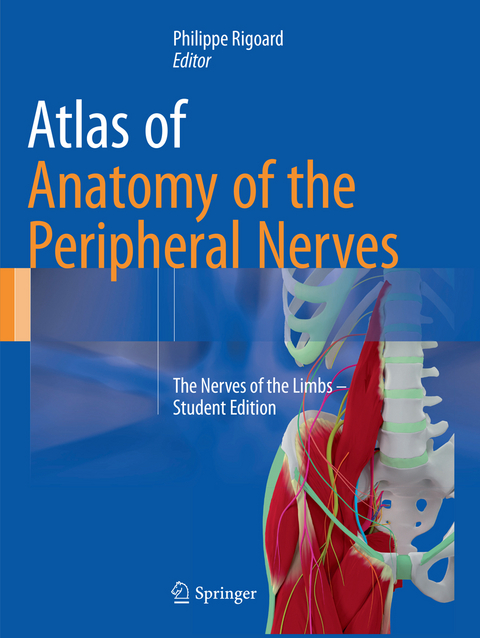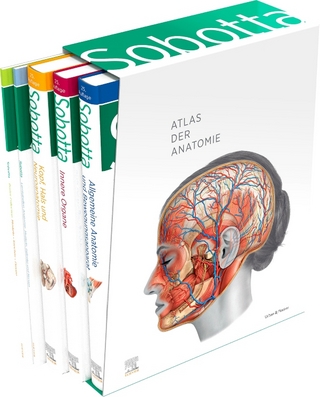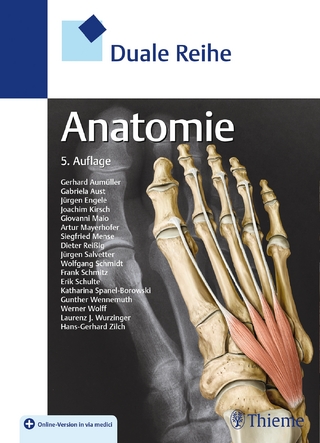
Atlas of Anatomy of the Peripheral Nerves
Springer International Publishing (Verlag)
978-3-319-82735-3 (ISBN)
This atlas also features 261 outstanding full-colour 2D and 3D illustrations. Each picture has been designed in 2D and 3D with a combination of the original editor's personal drawings/paintings and 3D-modeling tools. This book is a valuable resource for anyone studying medicine, anaesthesiology, neurosurgery, spine surgery, pain, radiology or rheumatology and is also of high interest to the whole medical community in general.
Prof. Philippe Rigoard is a Senior surgeon and coordinator of the Spine & Neuromodulation Unit within the Neurosurgical Department, at the Poitiers University Hospital, in France. He is also an Honorary Consultant at St Thomas & Guy’s Hospital, Pain clinic, in London, UK, an Anatomy conference reader at the Human Morphology Institute, Faculty of Medicine of the University of Poitiers and a Researcher at the Inserm, CIC (Clinical Investigation Center) 802. He is research program director of the N3Lab, Neuromodulation & Neural Networks Lab in Poitiers.In parallel of studying anatomy and morphology at National Art Institute, Beaux-Arts, Paris, from 1994-1996, he decided to enter into medicine. He received his medical degree as 1st Laureate of faculty of Medicine, Poitiers in 2006 and completed postgraduate medical training in spine surgery 2008 and a fellowship in functional neurosurgery in 2009.From 2002-2007 he also completed his PhD of Sciences, in Poitiers as well as several degrees including in Neuromuscular Diseases, acute pain, chronic pain and pain management in emergency conditions, microsurgical techniques and surgical robotics.His main research interest is neuromodulation and spine biomechanics. He has intensive scientific collaborations with several researchers worldwide, e.g., Dr. Kumar (Canada), Dr. Desai, Dr. North, Dr. Slavin (USA) and Dr. Al-Kaisy (UK). He is reviewer for many scientific journals and a member of several learnt societies, including the International Association for the Study of Pain, International Neuromodulation society, European Association of Neurosurgeons, French and North American Society of Spine Surgery. He has also published dozens of journal articles, abstracts, and book chapters, and has lectured at numerous conferences and symposia worldwide.
LIST OF CONTRIBUTORS.- FOREWORD.- ANATOMY PREAMBLE.- ABOUT THIS BOOKCONTENTS.- General introduction.- Part I: Morphological and functional anatomy of the peripheral nerve.- 1. The normal nerve.- 1.1. General organisation of the peripheral nerve.- 1.2. Structure and physiology of the nerve.- 1.3. Schwann cell and myelinisation.- 1.4. Mechanical properties of the nerves.- 1.5. Peripheral nerve vascularization.- 1.6. Junction and neuromuscular transmission.- 1.7. Main synaptic formation mechanisms.- 2. The injured nerve.- 2.1. Physiology of the injured nerve.- 2.2. Nerve degeneration.- 2.3. Neuron recovery mechanisms.- 2.4. Conclusion.- 3. Embryological development of peripheral nerves.- 3.1. Growth of the pioneer fibres.- 3.2. Development of the segmental spinal nerves.- 4. Development of limb innervation.- 4.1. Introduction.- 4.2. Notion of motor innervation.- 4.3. Notion of cutaneous innervation.- 5. Limb innervation in adults.- 5.1. Origin of the nerves of the limb.- 5.2. Constitution of the nerves of the limb.- 6. The notion of plexus.- Part III: The brachial plexus.- 7. Morphological data.- 8. Relations of the brachial plexus.- 9. Morphological data - MRI.- Part IV: Nerves of the upper limb.- 10. The axillary nerve.- 10.1. Morphological data.- 10.2. Morphological data - Motor branches.- 10.3. Morphological data - Sensitive branches.- 10.4. Morphological data - Cross-sectional view.- 10.5. Morphological data - MRI.- 10.6. Morphological data - Overview.- 10.7. Pathology.- 11. The musculocutaneous nerve.- 11.1. Morphological data.- 11.2. Morphological data - Motor branches.- 11.3. Morphological data - Sensitive branches.- 11.4. Morphological data - Overview.- 11.5. Morphological data - Cross-sectional view.- 11.6. Morphological data - MRI.- 11.7. Pathology.- 12. The radial nerve.- 12.1. Morphological data.- 12.2. Morphological data in the arm and elbow.- 12.3. Morphological data in the forearm.- 12.4. Morphological data - Overview.- 12.5. Morphological data - Cross-sectional view.- 12.6. Morphological data - MRI.- 12.7. Pathology.- 13. The median nerve.- 13.1. Morphological data.- 13.2. Morphological data in the arm and elbow.- 13.3. Morphological data in the elbow.- 13.4. Morphological data in the forearm.- 13.5. Morphological data in the hand.- 13.6. Morphological data - Overview.- 13.7. Morphological data - Cross-sectional view.- 13.8. Morphological data - MRI.- 13.9. Pathology.- 14. The ulnar nerve.- 14.1. Morphological data.- 14.2. Morphological data in the arm and elbow.- 14.3. Morphological data in the elbow.- 14.4. Morphological data in the forearm.- 14.5. Morphological data in the hand.- 14.6. Morphological data - Overview.- 14.7. Morphological data - Cross-sectional view.- 14.8. Morphological data - MRI.- 14.9. Pathology.- 15. Other nerves.- 15.1. The suprascapular nerve.- 15.1.1. Morphological data.- 15.1.2. Morphological data - Cross-sectional view.- 15.1.3. Pathology.- 15.2. The long thoracic nerve.- 15.2.1. Morphological data.- 15.2.2. Morphological data - Cross-sectional view.- 15.2.3. Pathology.- Part V: The lumbosacral plexus.- 16. The lumbar plexus.- 17. The sacral plexus.- 18. Relations of the lumbar and sacral plexuses.- 19. Overview diagrams of the lower limb plexuses.- Part VI: Nerves of the lower limb.- 20. The obturator nerve.- 20.1. Morphological data.- 20.2. Morphological data in the pelvis.- 20.3. Morphological data in the thigh.- 20.4. Morphological data - Overview.- 20.5. Morphological data - Cross-sectional view.- 20.6. Morphological data - MRI.- 20.7. Pathology.- 21. The femoral nerve.- 21.1. Morphological data.- 21.2. Morphological data in the abdomen and thigh.- 21.3. Morphological data in the thigh.- 21.4. Morphological data - Overview.- 21.5. Morphological data - Cross-sectional view.- 21.6. Morphological data - MRI.- 21.7. Pathology.- 22. The sciatic nerve.- 22.1. Morphological data.- 22.2. Morphological data in the buttock.- 22.3. Morphological data in the thigh.- 22.4. Morphological data - Overview.- 22.5. Morphological data - Cross-sectional view.- 22.6. Morphological data - MRI.- 22.7. Pathology.- 23. The tibial nerve.- 23.1. Morphological data.- 23.2. Morphological data in the calf and ankle.- 23.3. Morphological data - Neurovascular relations.- 23.4. Morphological data in the foot.- 23.5. Morphological data - Overview.- 23.6. Morphological data - Cross-sectional view.- 23.7. Morphological data - MRI.- 23.8. Pathology.- 24. The common fibular nerve.- 24.1. Morphological data.- 24.2. Morphological data at the neck of the fibula.- 24.3. Morphological data in the leg.- 24.4. Morphological data - Overview.- 24.5. Morphological data - Cross-sectional view.- 24.6. Morphological data - MRI.- 24.7. Pathology.- 25. The lateral cutaneous nerve.- 25.1. Morphological data.- 25.2. Morphological data in the thigh.- 25.3. Morphological data - Overview.- 25.4. Morphological data - MRI.- 25.5. Pathology.- 26. Other nerves.- 26.1. Morphological data.- 26.2. Pathology.- 27. General views.- INDEX
| Erscheint lt. Verlag | 10.8.2018 |
|---|---|
| Zusatzinfo | XXVIII, 322 p. 237 illus., 235 illus. in color. |
| Verlagsort | Cham |
| Sprache | englisch |
| Original-Titel | Atlas d'anatomie des membres - Nerfs peripheriques |
| Maße | 210 x 279 mm |
| Gewicht | 1233 g |
| Themenwelt | Studium ► 1. Studienabschnitt (Vorklinik) ► Anatomie / Neuroanatomie |
| Schlagworte | 3D • anatomy • Morpho-functional anatomy • Neuromuscular transmission • Pain Medicine • Peripheral Nerve • Plexus |
| ISBN-10 | 3-319-82735-9 / 3319827359 |
| ISBN-13 | 978-3-319-82735-3 / 9783319827353 |
| Zustand | Neuware |
| Haben Sie eine Frage zum Produkt? |
aus dem Bereich


